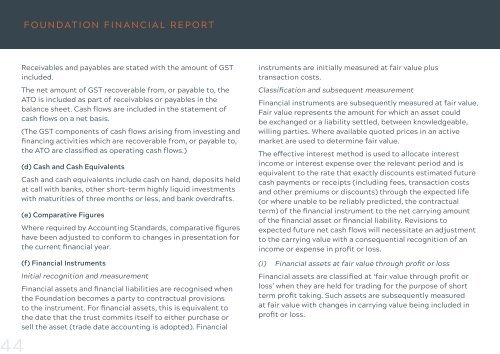Bendigo Art Gallery Annual Report 2017-2018
Bendigo Art Gallery Annual Report 2017/2018 outlines the activities of the Bendigo Art Gallery Board of Directors during 2017/18
Bendigo Art Gallery Annual Report 2017/2018 outlines the activities of the Bendigo Art Gallery Board of Directors during 2017/18
Create successful ePaper yourself
Turn your PDF publications into a flip-book with our unique Google optimized e-Paper software.
FOUNDATION FINANCIAL REPORT<br />
FOUNDATION FINANCIAL REPORT<br />
44<br />
Receivables and payables are stated with the amount of GST<br />
included.<br />
The net amount of GST recoverable from, or payable to, the<br />
ATO is included as part of receivables or payables in the<br />
balance sheet. Cash flows are included in the statement of<br />
cash flows on a net basis.<br />
(The GST components of cash flows arising from investing and<br />
financing activities which are recoverable from, or payable to,<br />
the ATO are classified as operating cash flows.)<br />
(d) Cash and Cash Equivalents<br />
Cash and cash equivalents include cash on hand, deposits held<br />
at call with banks, other short-term highly liquid investments<br />
with maturities of three months or less, and bank overdrafts.<br />
(e) Comparative Figures<br />
Where required by Accounting Standards, comparative figures<br />
have been adjusted to conform to changes in presentation for<br />
the current financial year.<br />
(f) Financial Instruments<br />
Initial recognition and measurement<br />
Financial assets and financial liabilities are recognised when<br />
the Foundation becomes a party to contractual provisions<br />
to the instrument. For financial assets, this is equivalent to<br />
the date that the trust commits itself to either purchase or<br />
sell the asset (trade date accounting is adopted). Financial<br />
instruments are initially measured at fair value plus<br />
transaction costs.<br />
Classification and subsequent measurement<br />
Financial instruments are subsequently measured at fair value.<br />
Fair value represents the amount for which an asset could<br />
be exchanged or a liability settled, between knowledgeable,<br />
willing parties. Where available quoted prices in an active<br />
market are used to determine fair value.<br />
The effective interest method is used to allocate interest<br />
income or interest expense over the relevant period and is<br />
equivalent to the rate that exactly discounts estimated future<br />
cash payments or receipts (including fees, transaction costs<br />
and other premiums or discounts) through the expected life<br />
(or where unable to be reliably predicted, the contractual<br />
term) of the financial instrument to the net carrying amount<br />
of the financial asset or financial liability. Revisions to<br />
expected future net cash flows will necessitate an adjustment<br />
to the carrying value with a consequential recognition of an<br />
income or expense in profit or loss.<br />
(i)<br />
Financial assets at fair value through profit or loss<br />
Financial assets are classified at ‘fair value through profit or<br />
loss’ when they are held for trading for the purpose of short<br />
term profit taking. Such assets are subsequently measured<br />
at fair value with changes in carrying value being included in<br />
profit or loss.<br />
(ii) Loans and receivables<br />
Loans and receivables are non-derivative financial assets with<br />
fixed or determinable payments that are not quoted in an<br />
active market and are subsequently measured at amortised<br />
cost.<br />
(iii) Held-to-maturity investments<br />
Held-to-maturity investments are non-derivative financial<br />
assets that have fixed maturities and fixed or determinable<br />
payments, and it is the Foundation’s intention to hold these<br />
investments to maturity. They are subsequently measured at<br />
amortised cost.<br />
(iv) Available-for-sale financial assets<br />
Available-for-sale financial assets are non-derivative financial<br />
assets that are either not capable of being classified into<br />
other categories of financial assets due to their nature, or<br />
they are designated as such by management. They comprise<br />
investments in the equity of other entities where there is<br />
neither a fixed maturity nor fixed or determinable payments.<br />
(v)<br />
Financial liabilities<br />
Non-derivative financial liabilities (excluding financial<br />
guarantees) are subsequently measured at amortised cost.<br />
Fair Value<br />
Fair value is determined based on current bid prices for all<br />
quoted investments. Valuation techniques are applied to<br />
determine the fair value for all unlisted securities, including<br />
recent arms length transactions, reference to similar<br />
instruments and option pricing models.<br />
Impairment<br />
At each reporting date, the Foundation assesses whether<br />
there is objective evidence that a financial instrument has<br />
been impaired. In the case of available-for-sale financial<br />
instruments, prolonged decline in the value of the instrument<br />
is considered to determine whether an impairment has arisen.<br />
Impairment losses are recognised in the Statement of Profit or<br />
Loss and Other Comprehensive Income.<br />
Derecognition<br />
Financial assets are derecognised where contractual rights<br />
to receipt of cash flows expires or the asset is transferred to<br />
another party whereby the entity no longer has any significant<br />
continuing involvement in the risks and benefits associated with<br />
the asset. Financial liabilities are derecognised where the related<br />
obligations are either discharged, cancelled or expired. The<br />
difference between the carrying value of the financial liability,<br />
which is extinguished or transferred to another party and the fair<br />
value of the consideration paid, including the transfer of noncash<br />
assets or liabilities assumed, is recognised in the Statement<br />
of Profit or Loss and Other Comprehensive Income.<br />
45


















